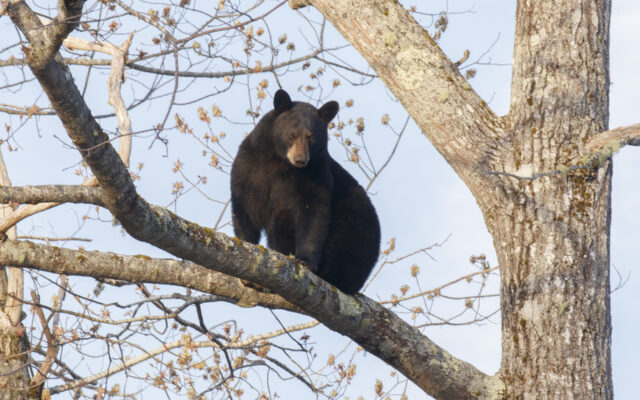
I made a big mistake with my backyard bird feeder
By Bob Duchesne
I love birds. Indeed, I love all wildlife. Well, OK, not black flies. Or ticks. But I love all other wildlife. Umm, maybe not bears on my porch.
Word had come down a week earlier. A bear and its two yearlings were visiting houses along my quiet, rural road after dark. Neighbors were urged to take precautions. I didn’t.
I live at the end of the road, surrounded on three sides by habitat that is unattractive to bears. I figured there was little chance they would make it down this far. In 22 years, a bear had visited my house only once.
That was about 17 years ago, and the result was an immediate need to replace all my unfortunate bird feeders, plus one or two mounting poles. I smugly assumed that after all that time, the likelihood of another visit was slim. It wasn’t.

VISITING – This black bear is among three that paid an unexpected visit to Bob Duchesne’s neighborhood recently. Mainers need to take daily precautions to avoid attracting the hungry animals at this time of year.
“Grab your camera,” my neighbor called as we converged at our mailboxes just past daybreak. High in a tree, perched above another neighbor’s garage, the three culprits lolled in the upper branches, hoping the humans wouldn’t notice.
They were laughably conspicuous. Even if they were better concealed, it would have been hard to ignore the trash strewn about a third neighbor’s driveway.
By now, several people were looking at them, accompanied by at least three unaware dogs. Up in the branches, the bears did not look angry. They didn’t even look nervous. They looked “inconvenienced,” and perhaps a little embarrassed to have been discovered. I took in my feeders.
Maine has the largest black bear population in the lower 48 states. It’s inevitable that we’ll bump into each other now and then. The Maine Department of Inland Fisheries and Wildlife gets hundreds of bear complaints every year.
Bears aren’t the problem. People are. Bears are attracted to garbage, bird seed, greasy grills, outdoor pet food and a host of other potential edibles.
A deeper challenge comes with encountering bears in the backyard. Wildlife managers are concerned about two separate problems: biological carrying capacity and social carrying capacity.
The first refers to how many members of a species can be sustained by the natural environment and habitat. When populations grow so large that they outstrip nature’s ability to nourish them, disease and starvation are inevitable.
Social carrying capacity refers to how big a population grows before it unduly affects human society. In the case of bears, if the population grows so large that they are forced into developed areas, contact can turn ugly.
A bear ripping up a bird feeder is a minor nuisance. In some states, foraging bears rip the doors off sheds and break into houses.
Bears aren’t the only problem. Deer are cute, until they start munching your peonies. Coyotes and foxes may stalk backyard pets. Even wild turkeys sometimes get a bad rap for poking their beaks where they don’t belong.
DIF&W oversees Maine’s wildlife management programs. There are plans for game species and different management plans for nongame wildlife. Carrying capacity, both biological and social, figure heavily in all the plans, affecting everything from hunting regulations to wetland protections.
As for the female bear up there in my neighbor’s tree, the first step in managing it is managing me. The DIF&W website has an entire page dedicated to living with bears. Advice is basically divided into two categories: remove and store inside.
When bears are active, take your feeders down at night and bring them indoors. Secure trash cans in the garage or shed. DIF&W even suggests using an electric fence around the trashcans, if indoor storage isn’t possible. Bring grills and pet food indoors.
Secure and clean. Rake up bird seed from the ground. Make sure garages and shed doors are closed, with windows shut. For grills that must remain outside — which is likely most of them — always burn off the grease after use. Make sure no food scraps or packaging is left around the grill.
Clean outdoor pet food bowls and bring any leftovers inside. This isn’t just good advice for bears. Raccoons and skunks are even more likely to roam deep into town.
The most important thing to remember is that bears should never learn to feel comfortable around people. Once a bear realizes it’s easy to find food in a human settlement, there is virtually nothing that will prevent it from returning. Even a bear captured and transported 100 miles away will typically find its way back.
The best solution is to make your neighborhood unbearable.